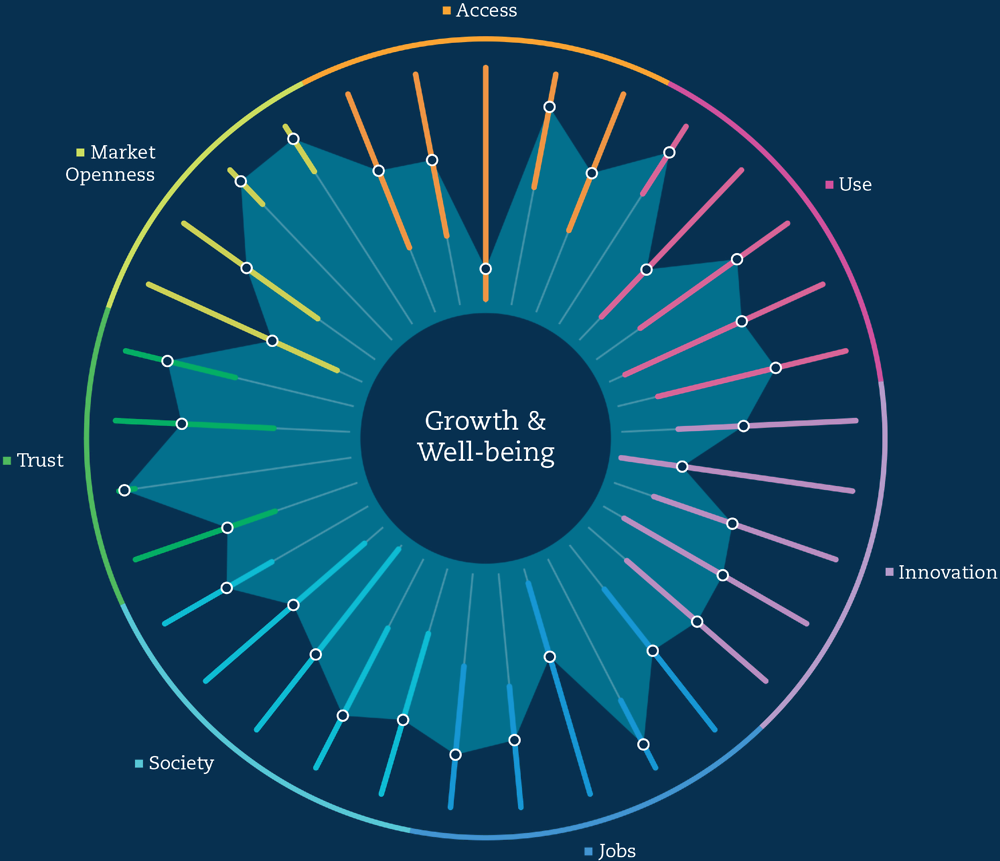Sound measurement is crucial for evidence-based policy making; it helps to identify the need for policy intervention, enhances accountability, and improves the evaluation of the efficiency and effectiveness of policy actions. The demand for useful data and measurement tools relating to the ongoing and accelerating digital transformation is particularly acute due to the wide-ranging role that digitalisation and digital technologies play in economies and everyday lives.
The aim of Measuring the Digital Transformation: A Roadmap for the Future is not to “rank” countries or develop composite indicators. Instead, its objective is to provide policy makers and analysts with key indicators for each of the dimensions of the Going Digital integrated policy framework but also additional indicators providing detail and nuance, and link to relevant policy levers, to give analysts, stakeholders and policy makers deeper insights into how their economies are performing along those dimensions. The publication draws upon the wealth of data available at the OECD, as well as other international organisations and private data providers.
A forward-looking measurement roadmap develops nine actions that, if prioritised and implemented, would substantially advance the capacity of countries to monitor the digital transformation and its impacts. The first four overarching actions are directed towards building the next generation of data and indicators capable of dealing with the challenges of the digital transformation: make the digital economy visible in economic statistics, understand the economic impacts of the digital transformation, measure well-being in the digital age, and design new and interdisciplinary approaches to data collection. Five further actions target specific areas identified as requiring attention: transformative technologies, data and data flows, skills in the digital era, trust in online environments, and governments’ digital strengths. The actions build on 19 roadmap pages, spread throughout the publication, that identify policy needs for measurement, discuss the challenges and propose options for international action.
Trends in the digital era (Chapter 1). This opening chapter sets the stage and develops a narrative around technology trends and digital transformations. It highlights trends rather than country comparisons and makes use of less-traditional data sources. The target audience is any person interested in understanding the broad picture and emerging developments. It highlights elements such as the rise of Big data analytics and artificial intelligence, the increased demand for cloud computing services, the nature of the global data infrastructure, the increasing digital transformation of all sectors, the impact of digitalisation on the workplace and on younger generations and scientists, and the evolution of “digital divides”. It also offers examples of the use of text-mining techniques, Internet-based statistics and online job vacancies to develop new indicators of interest.
Growth and well-being (Chapter 2). This chapter illustrates the contribution of information industries and economic activities undergoing digital transformations to growth, productivity, global production networks, the composition of demand, trade and jobs in global value added chains. It also looks at how digital technologies are used by citizens and provides examples of impacts on their well-being. The chapter includes three roadmap pages that examine how to measure digital intensity in sectors, explore indicators of well-being in the digital age and address the challenges of developing a digital “satellite account”.
Seven thematic chapters (Chapter 3 Chapter 9) align with the seven policy dimensions of the Going Digital integrated policy framework, as shown in the figure below. The narrative reflects priorities for government monitoring and action, from enhancing the availability and quality of the infrastructure (Chapter 3) to encouraging the effective use of digital technologies by individuals and businesses (Chapter 4); enabling the digitalisation of science, innovation, markets and governments (Chapter 5); ensuring good jobs and outcomes in the workplace (Chapter 6); monitoring societal impacts (Chapter 7); strengthening digital security, privacy and trust in online environments (Chapter 8); and fostering market openness (Chapter 9).
Issues related to education and skills are not singled out as separate dimensions in the policy framework; rather, they are explored as enabling factors for other dimensions. Likewise, indicators related to skills are proposed throughout the publication: Chapter 4 examines skills for the effective use of technologies; Chapter 5 on innovation looks at tertiary education in science, engineering and ICT; Chapter 6 on jobs highlights skills in the workplace and key skills for adaptability and resilience, education and training; Chapter 7 on social prosperity explores digital skills capabilities; and Chapter 8 on trust looks at digital security skills.
The target audience for the thematic chapters includes policy analysts with a certain level of sophistication in the use of indicators. Roadmap pages feature challenges and actions surrounding the Internet of Things, cloud computing services, open source software, online platforms, platform-mediated workers, e-skills, e-commerce, digital trade, and data and data flows, among others.
A smaller set of indicators for each of the seven dimensions of the policy framework have been selected for visualisation and international comparisons in the Going Digital Toolkit. The Toolkit also provides easy access to additional indicators from the publication, and the underlying data and databases, as well as related publications, policy guidance and more: www.oecd.org/going-digital-toolkit.

